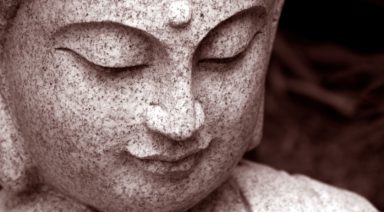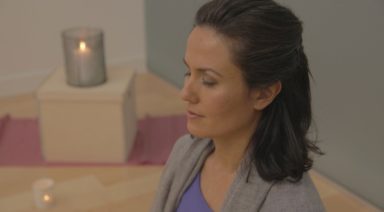The True Meaning of Aparigraha

I turned the corner onto my street, the street I have called home for the past three years, the one my son took his first steps in, where my daughter spent her first night in the world, where Christmas trees have come up and down, meals savored, and where laughter and crying have echoed through the hallways at all hours of the day. There, standing in my front yard, was the erected “For Sale” sign, signaling to ourselves as much as to everyone else in our community that we were done, we were letting go, moving on.
My heart broke the minute I saw the tall white sign in front of our little house on Placer. Not because it came as a surprise, but because suddenly I knew we were making a mistake. In reality, my husband and I had been talking about moving – to a new home, something bigger with more room, an expansive backyard, a new zip code – for years. Actually, it seems like we spent more time in our home talking about a new home than we did actually enjoying the space we were creating for ourselves and our growing family. Bookmarking houses on Zillow had become an addiction.
In fact, I had become so addicted to the thought of something new that I was completely oblivious to the reality in front of me. Like any addict, I was living in an altered state, one that was preventing me from seeing clearly the love, magic, and beauty of exactly where I was. The technological drugs I consumed were clouding my mind, offering me a constant drip of distractions. It was seeing my house officially for sale, cleaning it to prepare for showings, that woke me up and knocked me back into the reality I had been missing. But was it too late?
Offers were being made on our home, jobs being accepted out of state, apartment leases signed, boxes packed, all while my heart was flooding with regret.
Emotionally off kilter, I fled to my yoga mat, the one place that has consistently brought me peace and grounding for the past decade. I turned to sage advice, poring through the hand-written notes I had taken in the margins of books spouting eternal knowledge, everything from Patanjali’s Sutras to the Bible and, my other bible, Tina Fey’s Bossypants. While the Bible offered me inspiration and Bossypants offered a much needed laugh, it was in the Sutras that I found solace in the Yamas, the internal disciplines of yoga, particularly that of Aparigraha, or the practice of non-grasping, non-attachment.
Okay, I thought, as the final box was moved out of our home and into my parents’ truck. This is a practice; this is letting go. I will be alright, I reminded myself as I slid into the front seat of our family’s car. I have my children, my husband – everything I really need, everything that is really important, is coming with me. So we moved. Our house was still officially on the market with offers being made, but in my mind it was sold, the decision made. I was taking what I needed. Aparigraha was my bitch – I was rocking it hard.
Or, at least, like any egotistical, self-righteous idiot, that’s what I thought. Because, within a week of our big move, I was depressed. Depressed and anxious. Depressed and anxious and grumpy.
The Reality of Practicing Aparigraha
I kept saying, “This is an adventure! Make the most of it!” But no matter how hard I tried to “Aparigraha” it, I couldn’t shake the dark cloud that had moved over me, laying claim to my thoughts day in and day out.
Because family was still back home and because our “back home” home was still technically ours, we spent many weekends out of our new apartment and on the road. Each trip was an emotional rollercoaster for me. I was happy to be home but confused about the future. Would this be the last time we could open the front door of our house? What if we backed out? Could we still back out? What would people think if we did? What would I think if we didn’t?
Bittersweet isn’t exactly how I would describe what I was feeling. Each time we visited home, only to leave a day later to drive eight hours north, the taste became more bitter, sour even. But I was stubborn, repeating the mantra “Let Go” over and over, hoping to eventually crack whatever it was that was making it difficult for me to really accept all of the changes that were taking place.
Why is Aparigraha So Hard to Practice?
Still unable to shake the depression and anxiety that had befriended me at the New Mexico-Colorado state border, I dove deep into trying to better understand what practicing Aparigraha really meant. Is it really just letting go, detaching yourself? Or is there more to it.
I read what Nicolai Bachman had to say about the Yama, that by practicing Aparigraha, we discover why we were born. Or, less esoterically, he also says that the more we accumulate things the more time we have to spend maintaining said things, which means less time for internal development. Got it.
I tried to focus on the feeling of freedom, thinking that by leaving our home and our community we were on a path of new beginnings. I meditated on feeling light, no longer bound by old habits. I worked to open my eyes to what was before me, trying to soak in each and every new experience.
I’ll admit that it helped. That my days were more enjoyable. That I found reasons to smile and laugh. But at the end of the day, as I laid down to sleep, the depression would creep back in. I was still crying myself to sleep most nights, muffling the sound from my husband and children so they wouldn’t know how much I was struggling with these changes.
One day, while at my new job in Boulder, I came across a yoga video by Mara Branscombe called Aparigraha for Freedom and Abundance. Still on my quest to better understand this yogic principle, I put on my headphones and turned my attention to what she was saying. She explained it simply, so simply in fact that I didn’t register how profound her words really were. I came back to the video the next day and really heard her as she said, “Aparigraha is taking only what we need… taking only what serves us… letting go when the time is right. Aparigraha allows us to become more present by letting go of expectations.” I scrambled to find something to write this down on:
Let go of expectations. Let go when the time is right.
I finished what I was doing, tore out this page from my journal, and walked to the park behind the office. I sat for a long time in silence, contemplating these two sentences. I dropped into a place of mental stillness that had been evading me for months. As I settled in, I began to see images, screenshots of everything that was important to me: my children laughing, my husband smiling, spending time in nature, having long conversations with friends, making memories with family, my home. Yes, my home with its red front door, its stucco courtyard, the garden in the back that my husband built, the picnic table by our waterfall, the lights hung over our bed, the fireplace in our living room. I began to cry. And then I called my husband.
In the next 48 hours we were making a pilgrimage back to our home. Not to pack or clean, but to enjoy it. We made fires in our chiminea, ate meals outside, walked with the kids to the neighborhood park, took in the mountain views from our backyard. Finally, we were present together in its walls. Neither of us talking about what we need to do or what we should do, just enjoying the here and now. We listened to our kids laughing as they played chef in their bedroom. We took time to visit with neighbors. We fell in love all over again.
Discovering the True Meaning of Aparigraha
That night, as we decided to not sell our home, I finally understood what I needed to do to let go, to really practice Aparigraha. You could say that I had an awakening when it comes to understanding Aparigraha. I let go of the expectations others had placed on my shoulders. I let go of the burden I had given to myself. Instead of letting go of the wrong things, the things that really mattered, I allowed myself to let go of what didn’t.
Aparigraha isn’t about letting go of all things – it’s about letting go of the right things at the right time.
The art of the practice is finding space to think clearly enough to discern what needs to be held closely and what needs to be let go. In my case, I needed to let go of my ego, of my expectations of the big move. As I did, I found that I was clinging to something that wasn’t important – this new life I had imagined for myself – instead of fighting for what I really needed right now – my home and the community that comes with it.
Maybe one day it will be the right time to let go of my casita on Placer Drive, but I trust that until that moment comes, I will let go of the desire to change what is already so good. I will give up the drugs of overthinking and options, replacing the habit with long, deep sips of appreciating the present moment.
How to Practice Aparigraha on the Mat
Your yoga mat is a beautiful place to practice the art of “letting go”. Using your practice as a place to explore and investigate what you cling to and why is one of the most beneficial tools I have received from my decade of practice. For so many of us, our yoga practice becomes something that we get attached to (how it looks, how it makes us feel, etc.), rather than letting it be something that is truly supportive.
There is nothing wrong with having goals and milestones in your yoga practice, but be mindful of why those are there. How are they serving your well-being and that of those around you? When you can begin to allow your yoga practice to evolve daily, to allow it to ebb and flow with you through seasons of highs and lows, you are discovering the heart of Aparigraha.
Anytime I feel myself clinging to my physical practice, I turn to a softer, gentler form – like Yin. In doing so, I give myself the space and freedom to get to the bottom of what is really going on in my life. At the end of the day, your yoga practice is truly the best way to see your reflection.
Why Gratitude is the Secret to Getting Motivated

We all know how good it feels to be thanked for the things we do. Getting a thank you email from a friend is often enough to lift us up and energize us for the whole day. The irony in this magic formula is that it is actually the person doing the thanking that is getting the most out of this simple act. Being grateful changes how you feel about life.
Think of what you could do for yourself if you turned into a gratitude machine, pouring out your gratefulness 10 or 20 times a day. Now you might be thinking that sending out 20 thank you emails every day might be overkill. The thing is, it is not actually the physical sending of the thank you that generates the personal motivational jolt. This bump of energy comes from the self-reflective process and daily note taking about the people, activities, and situations for which you are grateful.





































